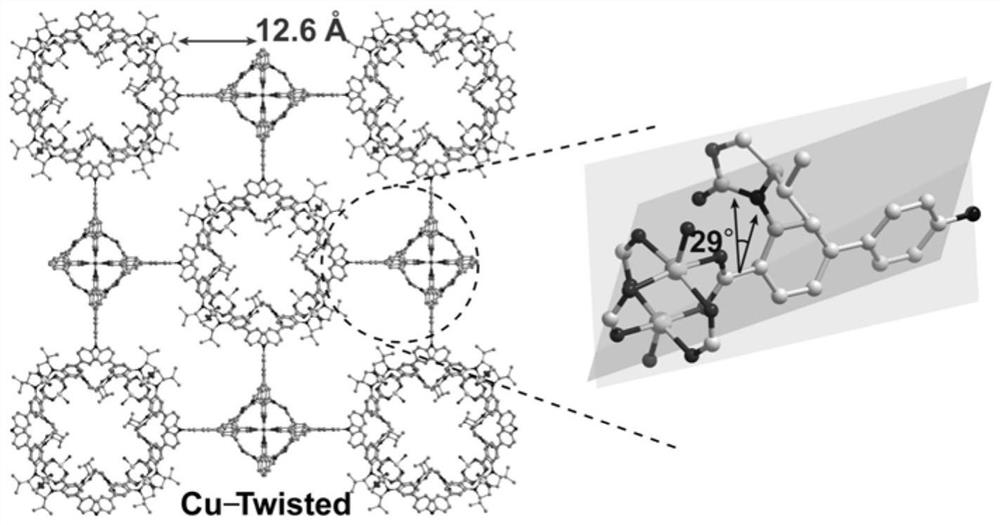Preparation method and application of metal organic framework catalyst with torsion structure
A metal-organic framework and catalyst technology, applied in the field of photocatalytic materials, can solve the problems of unfavorable catalytic reactions and efficient progress
- Summary
- Abstract
- Description
- Claims
- Application Information
AI Technical Summary
Problems solved by technology
Method used
Image
Examples
Embodiment 1
[0036] The preparation of Cu-Twisted comprises the following steps:
[0037] Step 1. Dissolve triphenylamine (10.0g, 40.8mmol) in 120mL N,N-dimethylformamide, and add N-bromosuccinimide (25.1g, 134.6mmol ) and stirred for 12 hours, added 150mL dichloromethane to dilute after the reaction was finished, then washed with deionized water and saturated sodium chloride solution successively, collected the organic phase and added anhydrous sodium sulfate to dry, poured 200mL into the organic phase after filtration Iced methanol, then filtered and collected the filter cake to obtain 16.7g of white needle-shaped solid, 85% of productive rate, and the H NMR spectrum was 1 H NMR (400MHz, CDCl 3 ) δ = 7.35 (d, J = 8.8Hz, 6H), 6.92 (d, J = 8.8Hz, 6H).
[0038] Step 2. Weigh the white needle-like solid (3.86g, 8.0mmol) prepared in step 1, bis-linked pinacol diboron (7.6g, 30.0mmol), potassium acetate (13.7g, 140.0mmol) and bis (Diphenylphosphino)ferrocenepalladium chloride (0.8g, 1.2mmol...
Embodiment 2
[0047] Preparation of Cu-Planar, the ligand H 3 Planar (180mg, 0.3mmol) and copper nitrate (241mg, 1.0mmol) were dissolved in a mixed solution of 40mL N,N-dimethylformamide and 10mL ethanol, and then 1.5mL was added to it at a concentration of 3mol L -1 Hydrochloric acid, after ultrasonic solubilization, sealed into a hydrothermal reaction kettle with a polytetrafluoroethylene lining, and placed in an oven at 85°C for 50h, then lowered to room temperature, removed the supernatant, and added ethanol to wash , and centrifuged to obtain 195 mg of green massive crystal Cu-Planar with a yield of 45%. Single crystal tests reveal crystallographic data for Cu-Planar: Molecular formula, C 78 h 48 Cu 3 N 2 o 15 , molecular weight Mr=1443.83, cubic crystal system, space group Fm-3m, green blocky crystal, unit cell parameter is α=β=γ=90°, The number of molecules in the unit cell Z = 16, the crystal density D c =0.168g cm -1 , the absorption factor is 0.119mm -1 , there are...
Embodiment 3
[0049] Add 5.3mg of Cu-Twisted and 3.5mg of Cu-Planar to 5mL of ethanol to make a suspension, then add 0.5mL of Nafin and mix by ultrasonic, take 80μL of the suspension and apply it on the surface of FTO glass, The coating area is 1cm 2 , dried, and then clamp the FTO glass on the electrode holder as the working electrode. The photocurrent test was carried out on a CHI 660E electrochemical workstation, using a three-electrode system, an Ag / AgCl electrode as a reference electrode, a platinum sheet electrode as a counter electrode, and 0.05M tetrabutylammonium hexafluorophosphate acetonitrile solution as an electrolyte. The current test is performed under the condition of 1atm oxygen, the temperature is room temperature, the light source is a 300W xenon lamp and the ultraviolet light band is removed through a 400nm filter. The test spectrum of photocurrent, such as image 3 shown. The test of electron sequential resonance is carried out on the A200-9.5 / 12 paramagnetic resonan...
PUM
 Login to View More
Login to View More Abstract
Description
Claims
Application Information
 Login to View More
Login to View More - R&D Engineer
- R&D Manager
- IP Professional
- Industry Leading Data Capabilities
- Powerful AI technology
- Patent DNA Extraction
Browse by: Latest US Patents, China's latest patents, Technical Efficacy Thesaurus, Application Domain, Technology Topic, Popular Technical Reports.
© 2024 PatSnap. All rights reserved.Legal|Privacy policy|Modern Slavery Act Transparency Statement|Sitemap|About US| Contact US: help@patsnap.com










